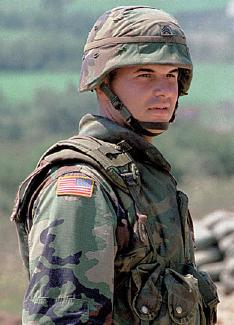Claim: Photograph shows a U.S. serviceman wearing a "DOING THE WORK OF" patch.
Example: [Collected on the Internet, 2004]
Origins: The image shown above began circulating on the Internet in early 2004 and is a digitally manipulated creation rather than a genuine

The appearance of the sergeant's sleeve has been altered in the Internet-circulated version to reflect the viewpoint that the
Nothing about the photograph indicates where the U.S. is doing the work of these other countries. Presumably it is meant to refer to the invasion and rebuilding of Iraq (although the serviceman pictured isn't wearing the familiar desert camouflage uniforms we're used to seeing in that part of the world), but it could technically refer to Afghanistan or South Korea or anywhere else in the world where U.S. forces are deployed.
The backward appearance of the U.S. flag on the serviceman's sleeve in this picture is not a mistake or anomaly. As the military newspaper Stars & Stripes explained, the flag patch worn on the right shoulder of a
Why do American soldiers wear the U.S. flag insignia "backwards" on the right shoulder of their utility uniforms, with the canton (the rectangle with the stars) on an observer's right?It's a question that soldiers hear frequently as they travel through civilian airports, or talk to members of other services.
And it does look "wrong," because U.S. federal code calls for the canton to always be positioned to the left.
The soldiers aren't wrong, however, and neither are their tailors,
Lt. Col. Stanley Heath, an Army spokesman, explained in a Friday telephone interview.The Army actually has two authorized flag patches, one to be worn on the left shoulder, with the canton facing left, and another "reverse field" patch worn on the right, with the canton facing right.
The two different orientations are mandated because Army regulations call for the flag "to be worn so that to observers, it looks as if the flag is flying against a breeze," Heath said.
What does a stiff wind have to do with this custom?
In fact, the rule is a nod to the U.S. Army's early history, when wars were fought as a series of carefully choreographed battles — two armies meeting on a field, clashing head-on until one side emerged victorious.
In those battles, both mounted cavalry and infantry units would always designate one soldier as "standard bearer," to carry the Colors into the fight.
As the standard bearer charged, his rapid forward momentum would cause the flag to stream back.
And since the Stars and Stripes is mounted with the canton closest to the pole, that section would always be forward.
So if a soldier is charging into the battle, the flag would give the appearance of forward motion. For the right shoulder, the flag only appears "backward."
And that's why soldiers wear the flag patches on the right shoulder "backward." Because retreat in battle, as any soldier will tell you, is not the Army way.
Last updated: 24 April 2004
 Sources:
Sources:Burgess, Lisa. "Is the Flag 'Backwards' on Soldiers' Sleeves?" Stars & Stripes. 28 February 2004.

